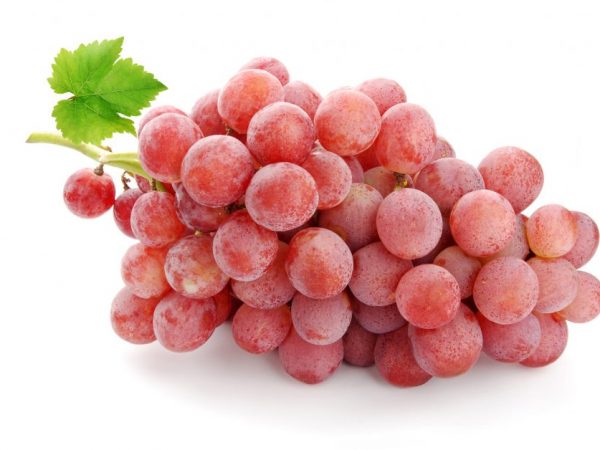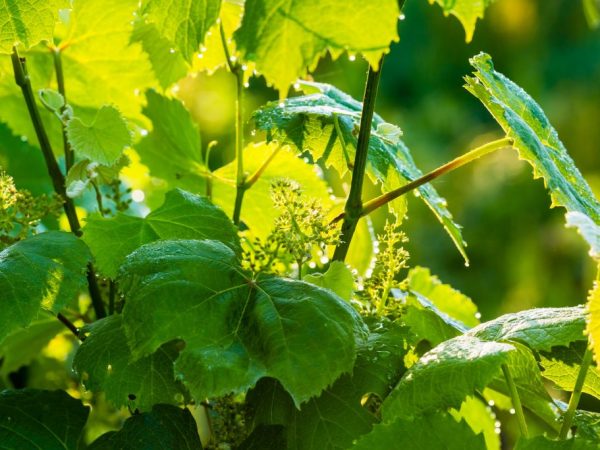Grape variety Red raisins
The Red raisin variety is a whimsical crop. For a good harvest, you will have to worry about the condition of the vine during winter frosts, as well as think about how to protect Red raisins from summer parasites.

Grape variety Red raisins
Variety characteristic
The ripening period of the variety is 113-123 days. The culture is an interspecific hybrid of the 4th class of seedlessness. The grapes are characterized by wide rooting properties and good rooting of cuttings. High vigor of shoot growth is noted.
The plant can withstand frosts down to -24 ° C. Under favorable conditions, flowering occurs in early June. Flowering is bisexual. Berry picking begins no earlier than 20 August.
Description of the vine
The vine is developing rapidly. From 25 to 35 eyes appear. The plant produces 20 to 25 shoots with a feeding area of 3-5 m².
Description of the fetus
The fruit has a medium density and a pronounced nutmeg taste. The berries are large oval in shape. The bunch is large cylindrical-conical with medium density. Weight of 1 berry is 5-6 g, bunches - up to 500-650 g. Each plant produces at least 6 kg of fruit.
Care
Pay attention to watering and pruning the bushes. Red raisins, according to the description, need constant watering, this should not be neglected.
To avoid a possible decrease in the volume and quality of the crop, you need to take care of the timely pruning of the vines. The normal number of shoots for a hardened bush will be 20-25 vines. For younger ones, don't leave more than 15.
Watering
Red raisins, like any grape variety, require a lot of moisture. For good growth, you need at least 35 liters of water per week. Watering breaks for more than 4 days are unacceptable. To save water, they use drip irrigation.
Before the start of harvesting, in about 2-3 weeks, you should give up full watering. Excess moisture will make the fruit look watery.
Top dressing

Fertilizers improve plant health
In the spring, it is necessary to nourish the bush with nitrogen fertilizing. After a while, you can add wood vines, potash and mineral fertilizers. For healthy growth, the bush needs:
- phosphorus;
- boron;
- zinc;
- nitrogen;
- zinc;
- potassium.
Bush formation
When pruning, take into account the rapid growth of the vine. The trim length should cover no more than 5-8 eyes.
Diseases and pests
The variety of raisins Red, according to the description, has a high resistance to fungal diseases. It copes well with a number of diseases and pests:
- mildew;
- gray rot;
- oidium;
- wasps and other parasites.
The best prevention for disease is to follow the rules of care. Timely watering and feeding reduces the risk of infection to a minimum.
The benefits of red raisins
Kishmish contains useful vitamins and minerals. The B vitamins contained in this variety have a beneficial effect on the nervous system. The berries of the culture are filled with nicotinic acid, which ensures the stability of the muscles and the entire human nervous system. The fruits contain ascorbic acid.Kishmish is able to strengthen the immune system and increase the body's resistance to harmful bacteria.
People suffering from high blood pressure, diseases of the autonomic nervous system, cardiac arrhythmias should include raisins in the diet, thanks to the potassium it contains, which has a positive effect on the cardiovascular system.
Due to the high concentration of oleanolic acid in this variety of raisins, it reduces the development and multiplication of bacteria in the oral cavity, which prevents tooth decay, gum and oral cavity diseases.
Boron, which is also present in grapes, prevents bone loss (osteoporosis).
Conclusion
Red kishmish is distinguished by its early ripening period. The fruits begin to be harvested at the end of the second half of August. The grape is notable for its pleasant Muscat arat.
Berries are great for wine or fresh consumption. Also, the plant is favorably distinguished by its high fertility and resistance to pests.


